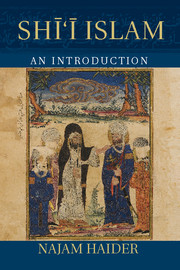Book contents
- Frontmatter
- Dedication
- Contents
- List of Tables and Maps
- Acknowledgments
- Note on the Cover Image
- A Note on Transliteration and Dating
- Maps
- Introduction
- Section 1 Theology
- Section 2 Origins
- Section 3 Constructing Shī‘ism
- 5 Zaydism in the Balance between Sunnī and Shī‘a
- 6 The Weight of Ismā‘īlī Expectations
- 7 Twelver Shī‘ism and the Problem of the Hidden Imām
- Section 4 Shī‘ism in the Modern World
- Appendix Verses Mentioned in the Argument from Qur’ānic Expectations in Chapter 3
- Index
- References
6 - The Weight of Ismā‘īlī Expectations
Published online by Cambridge University Press: 05 August 2014
- Frontmatter
- Dedication
- Contents
- List of Tables and Maps
- Acknowledgments
- Note on the Cover Image
- A Note on Transliteration and Dating
- Maps
- Introduction
- Section 1 Theology
- Section 2 Origins
- Section 3 Constructing Shī‘ism
- 5 Zaydism in the Balance between Sunnī and Shī‘a
- 6 The Weight of Ismā‘īlī Expectations
- 7 Twelver Shī‘ism and the Problem of the Hidden Imām
- Section 4 Shī‘ism in the Modern World
- Appendix Verses Mentioned in the Argument from Qur’ānic Expectations in Chapter 3
- Index
- References
Summary
The historical development of Ismā‘īlī Shī‘ism is closely tied to the practical problems that faced Imāms ascribed lofty and possibly unattainable expectations. These Imāms were often hidden from their followers, only to emerge at opportune moments to herald the creation of new states. The Ismā‘īlī doctrine of the Imāmate accorded them absolute political and religious authority and affirmed their privileged connection with God, their access to hidden knowledge, and their spiritual perfection. In contrast to the Twelver Shī‘a, who transitioned to a scholar-centered model of leadership after the disappearance of their last Imām, the Ismā‘īlī Shī‘a were consistently led by Imāms bearing the expectations of a final victory over all opponents. The weight of these expectations had an impact on their policy decisions and their articulation of important theological doctrines.
Ismā‘īlī Shī‘ism seems to have first materialized in an identifiable form in the late ninth century, when a number of branches appeared simultaneously across the Muslim world working in unison for the establishment of an ‘Alid-led Imāmate. The movement split into competing factions as a result of disagreements regarding the identity of the Imām and disputes over basic theology. This chapter is organized around three seminal periods in Ismā‘īlī history. It focuses particularly on the Nizārī Ismā‘īlīs, who today constitute a numerical majority of the Ismā‘īlī community. The first section discusses the group's origins and early development stretching from the death of Muḥammad b. Ismā‘īl to the public emergence of the Fāṭimid Imāms in 899. The second section covers the Fāṭimid dynasty in Egypt and the Nizārī state in Iran, between the late ninth and the mid-thirteenth centuries. The third section examines the obscure period from the fall of Alamut in 1256 to the migration of the Aga Khan to India in 1841.
- Type
- Chapter
- Information
- Shi'i IslamAn Introduction, pp. 123 - 144Publisher: Cambridge University PressPrint publication year: 2014

